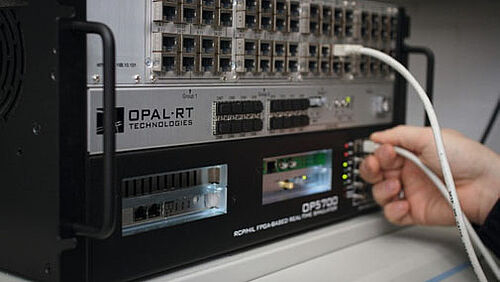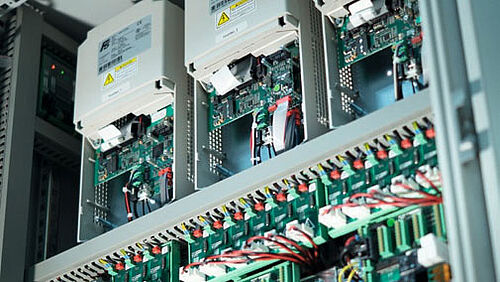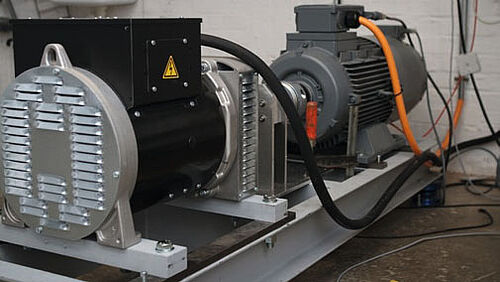
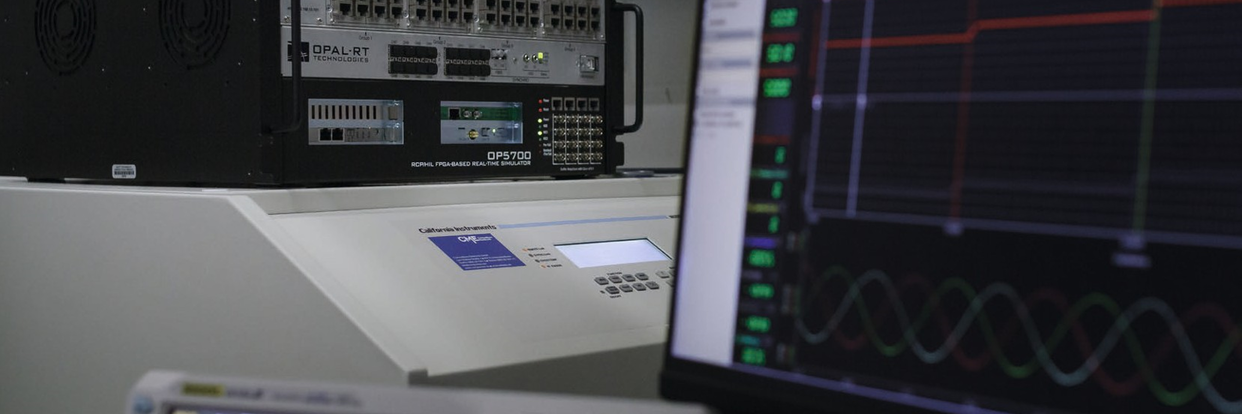
The name says it all: the Grid Dynamics Laboratory investigates current research topics related to the integration of renewable energy generation systems into the low-voltage grid. The focus is on highly dynamic, transient processes - the target is milliseconds to a few seconds.
A dedicated team of scientific staff, scientific assistants and the institute's own workshop work together energetically. A laboratory and its team introduce themselves:
About the laboratory - Central questions:
The goal of the research in the Grid Dynamics Laboratory is to think ahead to the energy transition. While the stability of conventional energy supply systems relies primarily on generator-based large-scale power plants from higher voltage levels, the feed-in structure is currently undergoing a major transformation. There is an increase in decentralized supply of electricity from converter-based, smaller plants at lower voltage levels. Renewable power plants use converters to deliver power to the grid, thus distinguishing them from conventional thermal power plants, which use large synchronous generators to deliver power. The requirements for modern generation plants in terms of to their behavior in a highly volatile, dynamic grid are manifold and subject to a high degree of complexity due to their power electronic characteristics, communication structures and their regulation.
Using scenarios in which this future power supply infrastructure is already being simulated in the laboratory today, the opportunities and challenges of a supply with a high proportion of renewable energies and electromobility are to be identified and investigated in advance.
This means fundamental changes in the characteristics of future grid infrastructures, in which the interaction of conventional and new types of power supply systems and controls for ensuring grid stability must be continuously re-evaluated. The Grid Dynamics Laboratory provides the necessary infrastructure: sources that can be flexibly arranged, grid simulations, loads, generation plants, freely parameterizable full converters, and power hardware-in-the-loop real-time simulators enable the mapping of a wide variety of scenarios, including critical situations: many things that one does not want to see in the real energy supply infrastructure can be tested and run through here without any consequences.
The laboratory environment focuses on tests and scenarios that deal with special load situations of grid components and the grid-serving potential of decentralized generation plants.
The Grid Dynamics Laboratory as a Service Provider for Research and Industry
In addition to our day-to-day research work, we regularly work on external assignments for external partners - from start-ups to large industrial customers.
For our customers, the focus is primarily on issues related to the safe operational management of equipment, software and/or hardware components in a mappable low-voltage environment.
Typical external tasks include:
The central issue for our energy supply system in the coming years will be the stable transition to a CO2-neutral power supply. From a technical point of view, this means the transition from a grid that is primarily defined by synchronous generators of fossil power plants to a grid structure that is operated by converters of regenerative power plants. This changes the fundamental behavior of the energy supply infrastructure in many ways. Reason enough to test this transition in the laboratory. For this purpose, the Grid Integration laboratory offers a coupled machine for testing grid-parallel operation of converters and synchronous machines under laboratory conditions.
The machine set is currently being installed in the laboratory and subjected to initial test runs. The specially designed concept for personal and hardware protection, control of the machine and coordination of various components involved in the operation enables safe laboratory operation for all future tests. For example, the current test focus includes the response of grid components to rapid jumps in grid phase and amplitude, usually caused by faults. Machines tend to oscillate in these situations, but are able to stabilize the grid by supplying short high overcurrent. Inverters can be more flexible, but are severely limited in their overcurrent capability. Can these systems complement each other in the transition? How can the grid be kept stable with varying levels of converter and machine penetration? How should converter controls be designed for this purpose? The Grid Dynamics Laboratory invites you to explore these questions.
The tests in our laboratory offer a decisive advantage for our research: scenarios or behaviors that have been conceived in abstracted and necessarily simplified simulations can be verified under more realistic conditions. These experiments are often more conclusive, and controls can be shown to work correctly in the real world for the first time. However, before implementing controllers in hardware, it is useful to test their operation in more flexible embedding scenarios. The Laboratory needs an integrated measurement and control option that works reliably and without delay in order to map network faults and controller behavior in the millisecond range.
For this purpose, a r High-Performance Real-Time Simulator has been added to the laboratory. The real-time simulator enables hybrid use cases of simulation and hardware in real time. This has several advantages: Simulations can be transferred to the laboratory step by step. A part of the experimental setup is performed by the laboratory devices, the rest takes place in the simulator. Devices and simulation model work together in parallel and in real time. Causes for deviations between simulation and laboratory test can be isolated and found better and in smaller steps. In contrast to the laboratory, a simulator allows the flexible representation of elements of the low-voltage network, e.g. machines with different inertias, batteries with different outputs, grids with different arrangements, which could only be simulated with great effort in the laboratory - all this can be changed here by mouse click. Failures in live elements can be simulated to help ensure personal safety and equipment protection.
Several student assistants are regularly on duty to support the scientific staff in the laboratory. Among other tasks, such as software implementation and control of components in the laboratory using programs such as LabVIEW or MATLAB/Simulink, but also the installation of electrical components or hardware in the laboratory, students can gain practical experience in the field of electrical installations, but also in the field of applicable theory of control and measurement technology.
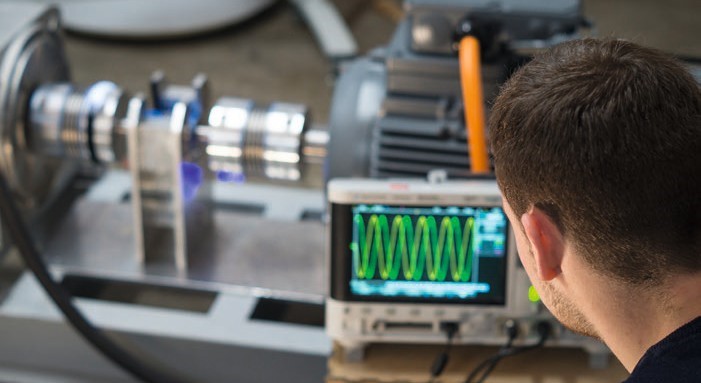
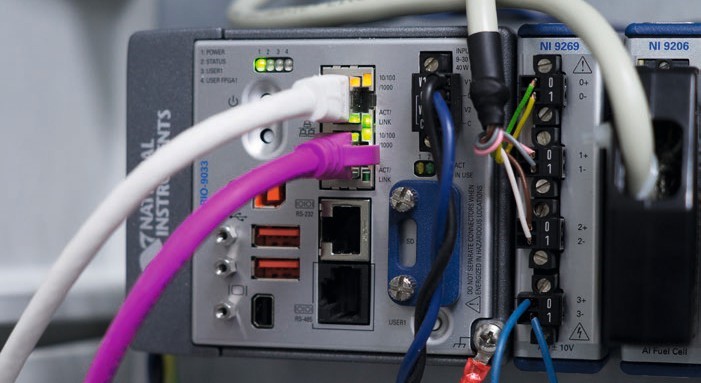
Various components such as inverters, AC and DC sources and loads, as well as a 50 kVA single line regulator, allow a complete low voltage line to be replicated or reproduced in the laboratory. To complete the low-voltage environment, up to 1.8 km of low-voltage cable can be simulated using flexibly adjustable resistors and inductors.
A powerful and accurate measurement system with 16-bit measurement resolution and a sampling rate of 500 kS/s enables precise and accurate work. Voltages up to ±1400 V and currents up to 200 A can be recorded and processed at various measuring points in the laboratory environment.
Some core elements and experimental components that define the central core points of the laboratory can are shown below:

